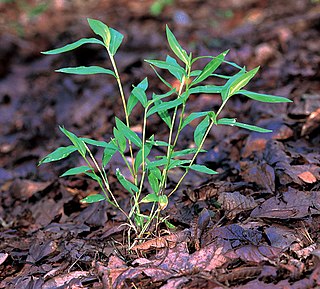
Pesticides are substances that are meant to control pests. The term pesticide includes all of the following: herbicide, insecticides nematicide, molluscicide, piscicide, avicide, rodenticide, bactericide, insect repellent, animal repellent, antimicrobial, fungicide, and lampricide. The most common of these are herbicides which account for approximately 80% of all pesticide use. Most pesticides are intended to serve as plant protection products, which in general, protect plants from weeds, fungi, or insects. As an example, the fungus Alternaria solani is used to combat the aquatic weed Salvinia.

Herbicides, also commonly known as weedkillers, are substances used to control unwanted plants. Selective herbicides control specific weed species, while leaving the desired crop relatively unharmed, while non-selective herbicides can be used to clear waste ground, industrial and construction sites, railways and railway embankments as they kill all plant material with which they come into contact. Apart from selective/non-selective, other important distinctions include persistence, means of uptake, and mechanism of action. Historically, products such as common salt and other metal salts were used as herbicides, however these have gradually fallen out of favor and in some countries a number of these are banned due to their persistence in soil, and toxicity and groundwater contamination concerns. Herbicides have also been used in warfare and conflict.
Roundup is the brand name of a systemic, broad-spectrum glyphosate-based herbicide originally produced by Monsanto, which Bayer acquired in 2018. Glyphosate is the most widely used herbicide in the United States. As of 2009, sales of Roundup herbicides still represented about 10 percent of Monsanto's revenue despite competition from Chinese producers of other glyphosate-based herbicides. The overall Roundup line of products, which includes genetically modified seeds, represented about half of Monsanto's yearly revenue. The product is marketed to consumers by Scotts Miracle-Gro Company.

Glyphosate is a broad-spectrum systemic herbicide and crop desiccant. It is an organophosphorus compound, specifically a phosphonate, which acts by inhibiting the plant enzyme 5-enolpyruvylshikimate-3-phosphate synthase. It is used to kill weeds, especially annual broadleaf weeds and grasses that compete with crops. Its herbicidal effectiveness was discovered by Monsanto chemist John E. Franz in 1970. Monsanto brought it to market for agricultural use in 1974 under the trade name Roundup. Monsanto's last commercially relevant United States patent expired in 2000.

A defoliant is any herbicidal chemical sprayed or dusted on plants to cause their leaves to fall off. Defoliants are widely used for the selective removal of weeds in managing croplands and lawns. Worldwide use of defoliants, along with the development of other herbicides and pesticides, allowed for the Green Revolution, an increase in agricultural production in mid-20th century. Defoliants have also been used in warfare as a means to deprive an enemy of food crops and/or hiding cover, most notably by the United Kingdom during the Malayan Emergency and the United States in the Vietnam War. Defoliants were also used by Indonesian forces in various internal security operations.

An agrochemical or agrichemical, a contraction of agricultural chemical, is a chemical product used in agriculture. In most cases, agrichemical refers to pesticides including insecticides, herbicides, fungicides and nematicides. It may also include synthetic fertilizers, hormones and other chemical growth agents, and concentrated stores of raw animal manure.

Agent Blue, is one of the "rainbow herbicides" that is known for its use by the United States during the Vietnam War. It contained a mixture of dimethylarsinic acid and its related salt, sodium cacodylate and water. Largely inspired by the British use of herbicides and defoliants during the Malayan Emergency, killing rice was a military strategy from the very start of US military involvement in Vietnam. At first, US soldiers attempted to blow up rice paddies and rice stocks, using mortars and hand grenades. But grains of rice were far more durable than they understood, and were not easily destroyed. Every grain that survived was a seed to be collected and planted again.

An environmental hazard is a substance, state or event which has the potential to threaten the surrounding natural environment or adversely affect people's health, including pollution and natural disasters such as storms and earthquakes.

Cacodylic acid is the organoarsenic compound with the formula (CH3)2AsO2H. With the formula R2As(O)OH, it is the simplest of the arsinic acids. It is a colorless solid that is soluble in water.

Picloram is a systemic herbicide used for general woody plant control. It also controls a wide range of broad-leaved weeds, but most grasses are resistant. A chlorinated derivative of picolinic acid, picloram is in the pyridine family of herbicides.

Soil contamination, soil pollution, or land pollution as a part of land degradation is caused by the presence of xenobiotic (human-made) chemicals or other alteration in the natural soil environment. It is typically caused by industrial activity, agricultural chemicals or improper disposal of waste. The most common chemicals involved are petroleum hydrocarbons, polynuclear aromatic hydrocarbons, solvents, pesticides, lead, and other heavy metals. Contamination is correlated with the degree of industrialization and intensity of chemical substance. The concern over soil contamination stems primarily from health risks, from direct contact with the contaminated soil, vapour from the contaminants, or from secondary contamination of water supplies within and underlying the soil. Mapping of contaminated soil sites and the resulting cleanups are time-consuming and expensive tasks, and require expertise in geology, hydrology, chemistry, computer modeling, and GIS in Environmental Contamination, as well as an appreciation of the history of industrial chemistry.

Calcium arsenate is the inorganic compound with the formula Ca3(AsO4)2. A colourless salt, it was originally used as a pesticide and as a germicide. It is highly soluble in water, as compared with lead arsenate, which makes it more toxic. The minerals rauenthalite Ca3(AsO4)2·10H2O and phaunouxite Ca3(AsO4)2·11H2O are hydrates of calcium arsenate.

Microstegium vimineum, commonly known as Japanese stiltgrass, packing grass, or Nepalese browntop, is an annual grass that is common in a wide variety of habitats and is well adapted to low light levels.

Pesticide drift refers to the unintentional diffusion of pesticides and the potential negative effects of pesticide application, including off-target contamination due to spray drift as well as runoff from plants or soil. This can lead to damage in human health, environmental contamination, and property damage.
The use of pesticides in Canada is regulated by the Pest Management Regulatory Agency, a division of Health Canada via the Pest Control Products Act. Pesticides are used predominantly by the agricultural sector. In 2016, 20% of reported pesticide sales were non-agricultural sector products, and just under 5% were domestic sector products.

Mesotrione is the ISO common name for an organic compound that is used as a selective herbicide, especially in maize. A synthetic inspired by the natural substance leptospermone, it inhibits the enzyme 4-hydroxyphenylpyruvate dioxygenase (HPPD) and is sold under brand names including Callisto and Tenacity. It was first marketed by Syngenta in 2001.

2,4-Dichlorophenoxyacetic acid is an organic compound with the chemical formula C8H6Cl2O3 which is usually referred to by its ISO common name 2,4-D. It is a systemic herbicide which kills most broadleaf weeds by causing uncontrolled growth in them but most grasses such as cereals, lawn turf, and grassland are relatively unaffected.

Bifenox is the ISO common name for an organic compound used as an herbicide. It acts by inhibiting the enzyme protoporphyrinogen oxidase which is necessary for chlorophyll synthesis.

Cyanazine is a herbicide that belongs to the group of triazines. Cyanazine inhibits photosynthesis and is therefore used as a herbicide.
Carol Van Strum is an American environmental activist who since 1975 has fought against the use of pesticides, including Agent Orange, for spraying the Siuslaw National Forest in Oregon. Her subsequent research, including over 20,000 documents revealing corporate and government cover-ups, was donated to the Poison Papers project in 2017. In 2018, Van Strum received the David Brower Lifetime Achievement Award for her contributions to forestry policy favoring selective harvest without the use of herbicides.
















